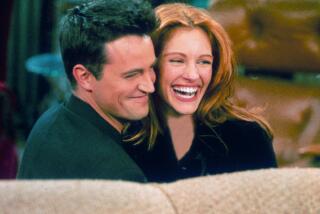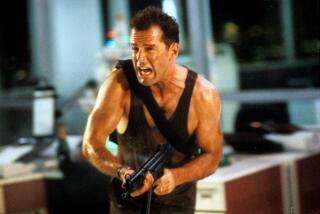Television : Struggles of an Epic Nature : Making ‘Citizen Kane’ brought on a legendary battle between Hearst and Welles. Revisiting that fight for ‘RKO 281’ was no easy matter either.
LONDON — It’s not often that the Victoria & Albert Museum, a magnificent 19th century building housing the world’s greatest collection of decorative art, gets to stand in for 20th century California. But on this occasion it’s the site for a replay of a crucial moment in Hollywood history.
The museum’s imposing, high-ceilinged Gamble Room has been dressed and transformed for a film, and at first sight looks mighty imposing. Period furniture, wall-hangings, works of art and objets d’art are carefully placed to suggest a very grand residence indeed.
It’s only when you look carefully that the illusion falls apart. All the artifacts in the room are in different styles, from various places and stages of history, and they sit awkwardly together under the same roof.
If this sounds faintly familiar, it should, especially if you’ve ever driven north from Los Angeles on Highway 1 and stopped at San Simeon to see Hearst Castle. The opulent home of publisher William Randolph Hearst combines walls, ceilings and floors from European churches with Moorish tiles and Gothic fireplaces. Medieval tapestries and Greek vases adorn many of its rooms.
Now the whole mishmash has been re-created here--not just at the V&A; (to give the museum its familiar title) but at St. Pancras railway station, a city center hotel, and the historic 15th century Guildhall, still the seat of London’s local government. “San Simeon is rather eclectic,” says production designer Maria Djurkovic diplomatically, “so for our purposes it’s a composite of real places.” Given the wildly contrasting styles to be found in Hearst Castle, it’s an appropriate decision.
Why is San Simeon being re-created? Because of Hearst’s opposition to “Citizen Kane,” the astonishing 1941 film debut by Orson Welles that was a thinly veiled biography of the newspaper magnate. He was particularly displeased when he learned of the film’s unflattering depiction of his real-life mistress, actress Marion Davies.
Hearst threatened the studio, RKO, with a massive lawsuit if it released “Citizen Kane” and reportedly discussed with other studio bosses the possibility of buying the film in order to suppress it--using as leverage the threat of exposing the private lives of Hollywood top brass in his newspapers if Welles’ film was ever released.
This unsavory episode in Hollywood history is the story of HBO’s “RKO 281,” which will premiere Nov. 20. (The title refers to the studio’s code name for “Citizen Kane.”) It was crucial to re-create Hearst Castle for “RKO 281;” in Welles’ masterpiece it was represented as the almost mythical Xanadu.
Liev Schreiber plays the flamboyant genius Welles, who was only 24 at the time of these events. John Malkovich plays Herman Mankiewicz, who with Welles wrote the “Citizen Kane” screenplay. Roy Scheider plays George Schaefer, who ran RKO studios at the time. James Cromwell plays the despotic Hearst, and Melanie Griffith is Marion Davies.
Why is it happening now? Partly because of a documentary, “The Battle Over Citizen Kane,” which was nominated for an Oscar three years ago. When director Ridley Scott saw it--according to Diane Minter Lewis, president of his production company, Scott Free, and also an executive producer of the film--”he said this is a feature film.”
Scott immediately began looking around for a writer and fixed upon John Logan, a Chicago-based playwright. He then shopped “RKO 281” around studios, hoping for a feature deal. But the project looked expensive, and Scott could not get a studio to commit.
Finally he decided not to try.
“I could do the film with a studio for in the high 30s [millions of dollars],” he said. “But honestly, it would have involved too much negotiation. HBO was interested. I thought, it’s better to do this with another director at a lower budget. Because I do like a big canvas.”
“[An HBO executive] had been tracking the script, and when it became apparent that no studio was going to do it, his persistence paid off,” said John Matoian, former president of HBO Pictures, during whose tenure the project began. “It was a handshake deal, but we said: This is a film we want to make.
“Ridley, to his credit, then got some serious [studio] interest, but said, ‘You guys stepped up, and we’re going to make it with you.’ ”
At one point Scott was also set to direct “RKO 281,” but he is now executive producer. (As the HBO film went into production, Scott was directing “Gladiator” for DreamWorks and Universal on the Mediterranean island of Malta.) He chose Englishman Ben Ross, who in 1995 made a well-regarded art-house movie, “The Young Poisoner’s Handbook,” to direct “RKO 281.”
Scott considered various locations for the project, even approaching the Hearst estate with a view to using San Simeon: “But I couldn’t get them to cooperate. The castle was left to the state of California, but when there are plans for films to be made there, I gather the family has a say.” (In fact, only documentaries and news stories are filmed at Hearst Castle--a condition of the Hearst gift of San Simeon to the state.)
The most practical answer was shooting in England; Scott jointly owns the sizable Shepperton Studios, near London, and notes, “There’s a dozen stately homes here with interiors as grand.”
*
None of the project’s complex history is apparent on the set. Extras in tuxedos, emerging from a banquet, promenade in twos and threes along the length of the Gamble Room. Two of these are Schreiber and Malkovich as Welles and Mankiewicz, earnestly discussing Hearst.
“It’s daunting,” said Schreiber, relaxing in his trailer after the scene. “First, I’m a Welles fan, which makes it intimidating for me to play the role. Second, I never really believed in bio-pics, especially with contemporary characters. The audience tends to draw comparisons rather than identifying with characters, which is awkward for the actor.”
The eloquent, insightful Schreiber, who jokingly comments he has gotten accustomed to playing “the best friend’s niece’s boyfriend parts,” is happy to have a meaty role to sink his teeth into.
But, he admitted, “I feel responsible for the reputation of an icon of film history. When the character is someone who had an influence on you and your life, it’s difficult to dissociate yourself from personal feelings.
“I know [director] Peter Bogdanovich, who was a friend of Welles, hates the idea of this movie. Beatrice [Welles’ daughter] has seen the script and said, ‘Oh, he wouldn’t do that, he wouldn’t say that.’ I just feel, well, I’m a guy taking a job, and it’s a lot better than ‘Scream 3.’
“At the end of the day they’ll probably hold me responsible. It goes with the territory.” He sighed. “I just wish I didn’t care so much.”
Schreiber is heavy-set, though not to the extent of Welles as a young man, and certainly not as an older man, when he was grossly overweight. “But I’ve gained 25 pounds,” he said. “It’s the most fun I’ve ever had preparing for a part. I’ve been lolling around London eating butter and ice cream, and steaks every night. I’ve no idea how I’ll get it off. I’ve never been good at training.”
The actor also has a baritone voice, which enables him at least to suggest Welles’ sonorous delivery. “I have nothing like the voice he had,” Schreiber said. “It’s important not to try and mimic him. I’ve seen actors do that in bio-pics. I watch their impression, then I no longer have any interest in the story.”
“RKO 281” comes along at a point when Welles’ reputation is at the highest point since his death in 1985. One of his unproduced scripts, “The Big Brass Ring,” with William Hurt and Nigel Hawthorne in starring roles, recently was seen on Showtime. And Tim Robbins’ new film, “The Cradle Will Rock,” heavily features an incident in which Welles’ 1937 production of an opera about the unionization of America’s steel industry was postponed by government officials, who sealed the New York theater in which it was to be performed.
Schreiber thinks Welles’ career, and “Citizen Kane” in particular, was prophetic of today’s independent film industry, which is why Welles now has so many admirers among young filmmakers.
“With him, it was hustle and shoot, hustle and shoot,” Schreiber reflected. “Shoot fast. Don’t let them know what we’re up to, then we can get away with something really interesting. With ‘Citizen Kane,’ Welles and his Mercury Players had never done a film before. They had no preconceived notions of a how a film should be done. Yet they had this incredible contract from RKO with complete creative control. It was the first real rift in the fabric of the studio system.”
Welles is also a hero of screenwriter Logan, who begged to be allowed a chance to meet Scott when he knew “RKO 281” was in the cards. “I did research for two solid months, I read all the biographies, I watched ‘Citizen Kane’ twice a week for two months. And when I finally met Ridley, I talked for two hours.”
Logan’s script intriguingly places Welles and Hearst as mirror images--powerful, not dissimilar men, despite their mutual dislike. Both were manipulative and vainly seeking love in their lives. “When such people have titanic power, they can create wonderful things and negative things,” Logan noted. “It would have been easier simply to make Hearst the villain, but I don’t think that would have been just.”
Scott, too, cites Welles as one of his main early influences, along with directors David Lean, Carol Reed and Michael Powell. “There was something about films from that period,” he said. “The style, the detail, the lighting, everything was important. It made those films a total experience, and that’s been watered down today, partly because there’s more demand for product.”
For Ben Ross, the decision to direct “RKO 281” was more pragmatic. After “The Young Poisoner’s Handbook,” he saw another film he had been preparing and writing for two years collapse shortly before the start of production. “I need to enjoy my work again after what was a lot of hardship,” he said.
“I had my eye on this project a while ago, because I thought it might be something worth doing. It’s interesting that we’re now at a stage in history where we can make referential films about classic Hollywood in an interesting way, make films about filmmakers that are properly informed.”
Ross and Scott concurred that the budget for “RKO 281” was about $12 million--less than a third of the budget Scott proposed for a feature movie. It will be among HBO’s “event films.” If there are lingering regrets that it will be a TV movie, not a feature, they are not expressed. And the expectation is that the film will look expensive. “I’ve had the dailies sent to me in Malta,” Scott said. “Ben has shot the film with a lot of style.”
Production designer Djurkovic agreed. “We don’t have an extravagant budget, though it’s bigger than most films shot in Britain. We have 60 sets and locations, and they all have that sense of scale. Nothing’s little anywhere.” How fitting for a film about a larger-than-life talent like Orson Welles.
More to Read
The biggest entertainment stories
Get our big stories about Hollywood, film, television, music, arts, culture and more right in your inbox as soon as they publish.
You may occasionally receive promotional content from the Los Angeles Times.










